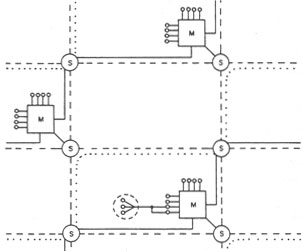Ether 5 ARPANET
Highways, however, are still too tied to the physical realm and were only a transitional step toward immaterial culture.
In the 1960s, Paul Baran, a researcher at the RAND corporation, a Cold War think tank, made the first attempt to realize a networked society. Baran feared that the highly centralized model of communications used in both civilian and military realms made them vulnerable to nuclear attack. With the loss of the center, all communications would be destroyed.
In its place, Baran developed a system of distributed communications that could survive a nuclear war in which each point functioned as a node and central functions were dispersed equally. Designed not for present efficiency but for future survivability even after heavy damage, Baran’s system broke messages down into discrete units or “packets” and routed them on redundant paths to their destinations. Errors were not avoided but rather expected. This system had the advantage of allowing individual sections of messages to be rerouted or even retransmitted when necessary and, as computers tend to communicate to each other in short bursts, would also take advantage of slowdowns and gaps in communication to optimize the load on the lines. Nodes would avoid vulnerable city centers located instead in the countryside.
ARPANET would be the first successful inter-city data communications network. Established after the launch of Sputnik to ensure US scientific superiority, the Department of Defense’s Advanced Research Projects Agency was located in universities throughout the country, spurring on the development of high technology in the sciences through projects such as the Orion nuclear powered rocket. ARPANET was an attempt to create an effective human-computer symbiosis for the agency. More than that, however, ARPANET was intended to build community and overcome isolation between the fifteen offices of the Information Processing Techniques Office [IPTO] without undoing the wider range of possibilities created by the diversity their separation entailed. Collaboration was intended to emerge through the experience of working together informally with shared resources. Eventually email would be developed and supplanted remote time-sharing as the network’s primary use.
